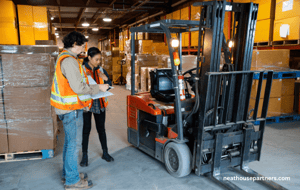Poor leader knowledge of health & safety is a critical problem for workers
A 2024 Safety Culture Maturity Report has revealed that poor leader knowledge of health and safety can pose great risks to workers, leading to increased numbers of accidents and injuries in the workplace.
James Rowland
Commercial Director James leads Account Management, Sales and Marketing at Neathouse Partners.Date
17 July 2024Updated
17 July 2024
Table of contents
Related articles
Insufficient health and safety knowledge among business leaders is putting UK workers at risk
Safe365 recently published a Safety Culture Maturity Report – a document that is the first of its kind, offering an in-depth analysis of worldwide health and safety practices across businesses ranging from 20 industries (including the UK, Australia and New Zealand).
The report offers some detail on positive advancements, and where things need to be significantly improved to prevent harm and increased levels of risk in the workplace.
The report assessed data from 10 main health and safety areas, including data collection, manager knowledge, worker and contractor engagement, and preparations for emergencies.
The findings revealed significant disparities, particularly with SMEs found to be 17% less prepared for emergencies when compared with larger companies.
Certain industries showed notable weaknesses in performance maturity. The IT and media sectors scored the lowest at 41%, followed by arts and recreation and public service at 42%. In contrast, sectors such as mining, utilities and professional services demonstrated higher maturity levels at 57%, 56%, and 55% respectively.
Key takeaways from the 2024 Safety Culture Maturity Report
- Health and safety management across organisations is generally meeting its obligations, but needs to be more proactive so it becomes less procedure-focused.
- On average, the difference in safety culture maturity between small and large organisations is less than 10%.
- Audit and verification are the two areas that need the most work in safety culture across various sectors.
- Practice assurance and control effectiveness need work across various industries.
- There is an average of 17% difference in emergency preparedness maturity between SMEs and large enterprises. (Increasing emergency situations impact all companies).
- Safety culture maturity is being held back by a lack of director and management knowledge.
- The weakest part of personnel safety culture is having effective systems for contractor management safety.
- In many companies, health and safety is still mainly overseen and reliant on one individual rather than a team of trained people.
Reducing harm by building people’s capabilities
One powerful insight from the report is that business leaders and influencers should focus on reducing harm by empowering people to make the right decisions when facing risks. Instead of creating more regulations, it's about following instincts and people's capabilities to do the right thing when faced with a health and safety emergency.
The report highlights a strong focus on having health and safety management plans with policies and procedures, but there also needs to be an improvement in human behaviours towards those policies. By improving attitudes towards health and safety, this ensures that the excellent work in health and safety management systems is reflected on-site and in workplaces.
Lack of director and management knowledge puts workers at risk
Another insight is that senior leadership often lacks effective understanding of health and safety governance. The report shows that directors and managers often have limited knowledge of risk management and industry-specific safety practices. This gap weakens their ability to govern effectively, leading to poor health and safety and investment choices.
Directors and managers need a better understanding of safety governance to ensure risks are well understood. They should ask the right questions, exercise visible leadership, and address safety issues with a can-do approach.
Effective data, such as risk assessments and incident reports, is really important for managing workplace risks and ensuring compliance. Investing in training for directors, senior management and safety professionals helps meet high level safety standards. This enables leadership to remain accountable, too.
Health and Safety lawyer Dr. Simon Joyston-Bechal claims that many directors have little understanding of their personal legal responsibilities in terms of health and safety. He emphasises that many companies are still struggling due to this lack of understanding.
With the UK's new Labour government expected to enforce stricter measures through the Health & Safety Executive, directors must understand that they could face personal criminal prosecution and potential jail sentences if they do not meet the standards expected within their roles.
Safety goes beyond compliance
The report also suggests that many businesses view risk management from a regulatory perspective only, assuming that compliance equals safety. However, compliance is just the minimum requirement, and doesn’t guarantee comprehensive safety.
Safe365's report indicates that responding to safety issues after they occur is more common than taking preventive measures. Proactive health and safety efforts are not adequately recognised. There's also a consistent weakness in monitoring and assurance across many industries, leading to a focus on meeting specific safety rules and legislation rather than effectively reducing risks.
Jason Anker MBE, Chairman & Director of Anker & Marsh, who suffered life-changing injuries in a workplace accident, stresses the importance of proactive safety measures. He emphasises that proper workplace safety requires a culture focused on safety itself, starting from senior leadership, to protect the many people affected by workplace incidents annually in the UK.
Let's work together
Our experts at Neathouse Partners can not only help your business with all aspects of health and safety law and compliance – including fire risk assessments, creating policies and procedures and e-learning but help you improve the maturity of your safety culture through providing programs and initiatives to all levels of your organisation.
We also offer health and safety management software to help you record hazards more effectively.
Related blog posts

Health And Safety Advice For Start-Ups And SMEs

Hot Weather Working - Supporting Staff and Understanding Their Rights

Employees' rights at work during cold weather

Forklift Truck Workplace Safety
Have questions?
Get in touch today
Contact us, and our team will get back to you within 24 hours. We value your questions and are committed to getting them answered quickly.


Hello! I am Nicky
Just fill in the form below with your details, and I will arrange for a member of our team to give you a call.
By clicking, you agree to our Privacy Policy




